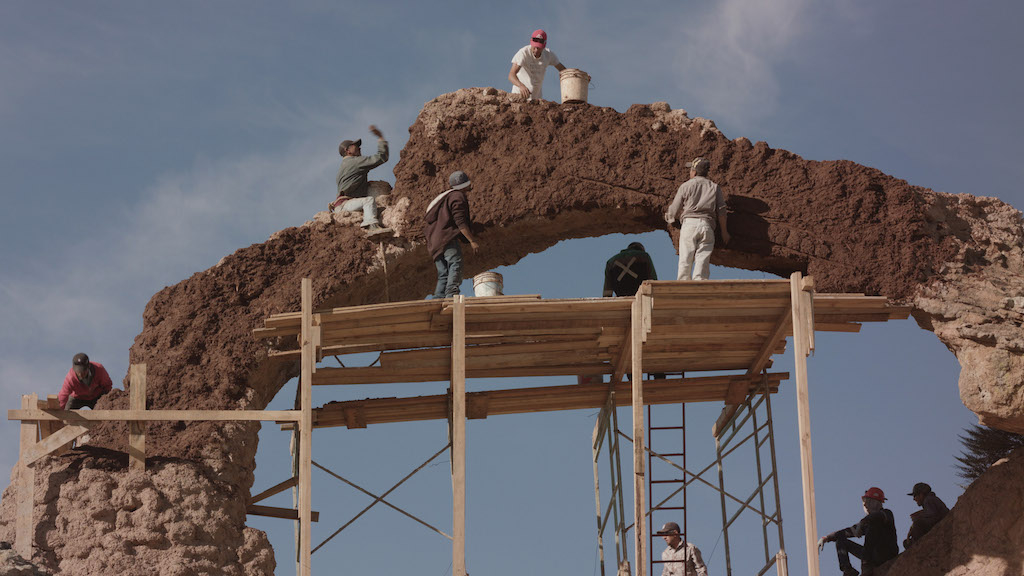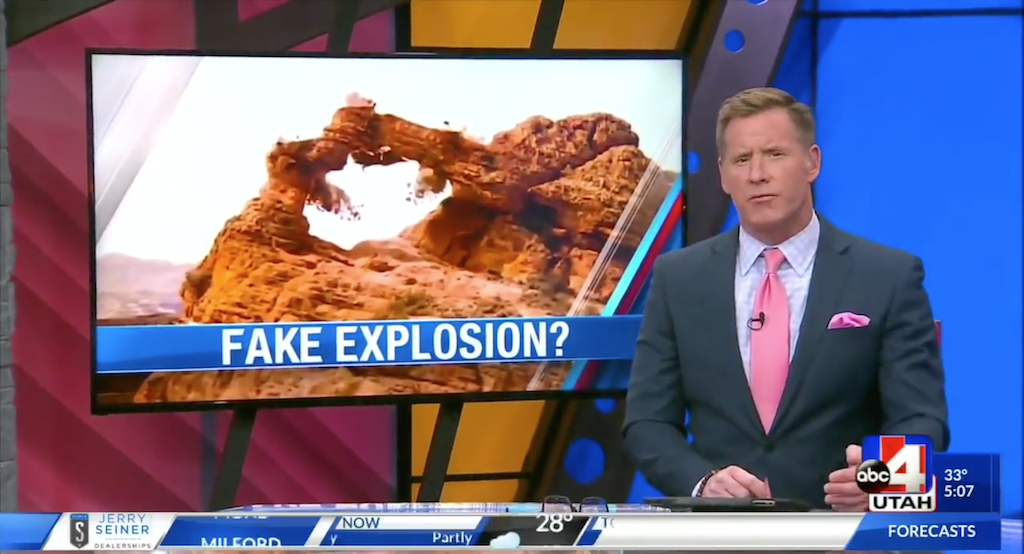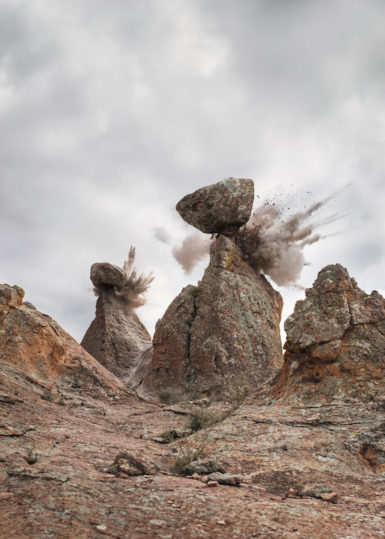[ad_1]

Construction of an artificial arch in I Am Afraid, I Must Ask You to Leave, 2018, film still.
© JULIUS VON BISMARCK AND JULIAN CHARRIÈRE AND VG BILD-KUNST, BONN, GERMANY
Last December, news outlets including Fox, ABC, and the Salt Lake Tribune reported on mysterious YouTube videos that showed two exploding rock formations in Utah’s Arches National Park. Some speculated over the scenarios’ authenticity, but the footage looked real enough that the Utah Department of Natural Resources sent staff to assess any possible damage to the landscape. When they found no resources were destroyed, however, authorities concluded that the videos were fake—answering a question posed by a local news report broadcast by Utah’s ABC 4: “Is it real vandalism or a very realistic looking hoax?”
The confounding videos proved to be part of a conceptual artwork through which two Berlin-based artists—Julius von Bismarck and Julian Charrière, who previously collaborated on a site-specific performance for the 2012 Venice Biennale of Architecture—set out to learn how the public would react if protected natural monuments and ancient geological forms were destroyed. The idea for the project—titled I Am Afraid, I Must Ask You to Leave—was inspired in part by recent instances of cultural destruction such as the attacks against ruins in the Syrian city of Palmyra and the monumental Buddha statues of Bamiyan in Afghanistan.
But the project also aimed to question systems through which information—and misinformation—spreads in our current media age. To do so, von Bismarck and Charrière constructed enormous artificial models of the arches and hoodoos found in the American Southwest (with materials including stone, stand, clay, and wood) and detonated them with dynamite. When they posted videos of the would-be cataclysms to the Internet, they were surprised by how quickly the media picked up the story—but even more so by how reporters focused on trying to debunk the happenings as computer-generated scenes. (“It just seems too art-directed and pretty,” Ben Burrell, a visual-effects specialist, said of the videos in an interview with Fox 13.)

An ABC news report about Julius von Bismarck and Julian Charrière’s conceptual art project.
COURTESY THE ARTISTS
“Experts went crazy trying to find where we hid the fraud,” von Bismarck and Charrière told ARTnews in a joint written response to questions about the project. “It didn’t occur to anyone that the truth could lie between real and fake, and that someone could have built something in an unknown landscape.”
For their experiment, von Bismarck and Charrière wanted to “target” a recognizable and iconic site, and they concluded that the natural wonders of Utah symbolize the landscape and identity of the American Southwest—so much so, they noted, that an image of an arch can be found on the Utah state license plate. “There are so many of them within the Utah National Park,” von Bismarck and Charrière said, “that it is impossible to place all of them by heart.”

Julian Charrière and Julius von Bismarck, Canyonlands, We Must Ask You to Leave (vertical viewpoint), 2018, film still.
© JULIUS VON BISMARCK AND JULIAN CHARRIÈRE AND VG BILD-KUNST, BONN, GERMANY
After three months in northern Mexico with a team of 35 builders, architects, and others who helped, the artists committed their work to video. With only one take per explosion, they had to get it right the first time, so they documented the process of constructing the models beforehand and then filmed and photographed the destruction in action. The third and final part of the project was a six-screen installation showcasing the public reception of the videos.
“In a way, it could be described as quixotic: this idea of trying to recreate life-size natural formations,” von Bismarck and Charrière said. “Over the years, these locations have become places of pilgrimage and cult, attracting thousands of tourists who want to experience a more than natural nature.”
When an anonymous user posted one of the artist’s YouTube videos to LiveLeak, a sharing platform that aims to empower citizen journalists, the work was well on its way to becoming an Internet sensation. From there, it garnered coverage from media “without any kind of information to back it up,” the artists said.
“We were amazed to see how these channels reported it without having any source. People really trust these platforms, and it was fascinating to be part of this snowball effect,” they said.
From the beginning of the project, von Bismarck and Charrière imagined ways that it might be presented in museum and gallery settings. Documentation of the work was shown first last year in an exhibition at the Kunstpalais Erlangen in Germany, and it has since been shown at Sies + Höke gallery in Dusseldorf and the Art Cologne fair. It also figured in von Bismarck’s recent solo exhibition at the Museo d’Arte Moderna di Bologna in Italy.
“We wanted to create a new work through the Internet and then transpose it into an exhibition space,” the artists said of a project that took on forms they hadn’t imagined at the start. “No one ever thought these videos could show something real.”
[ad_2]
Source link

